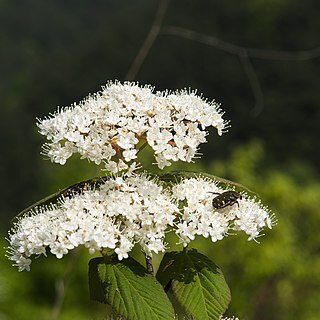Shrubs, deciduous, to 3 m tall. Bark light brown. Branchlets of current year densely stellate-pubescent and mixed with simple long hairs; branchlets of previous year gray-brownish, terete, glabrous, with sparse, small, rounded lenticels. Winter buds ovoid-oblong, with 2 pairs of separate scales; scales densely yellowish brown stellate-pubescent and mixed with simple long hairs. Leaves always opposite, not clustered at apices of branchlets; stipules 2, subulate, small, persistent, or absent; petiole green, robust, 3-5 mm, with coarse short hairs; leaf blade yellowish green when young, ovate-lanceolate, ovate-oblong, narrowly ovate, elliptic, or oblong-lanceolate, 3.5-6 × 1.5-3.5 cm, papery, abaxially densely stellate-pubescent, adaxially glabrous or sparsely stellate-pubescent, midvein raised abaxially, lateral veins 7-10(-14)-jugate, pinnate, straight or slightly arched, rarely branched, ending in teeth, conspicuously raised abaxially, impressed adaxially, veinlets transverse, slightly raised abaxially, impressed adaxially, not lobed or sometimes almost 3-lobed, base rounded, broadly cuneate, or slightly cordate, or sometimes shallowly 2-lobed, with 0 or 1 circular gland on both sides of midvein near base, margin serrate, apex acute or acuminate. Flowers appearing after leaves; inflorescence a compound umbel-like cyme, at apices of short lateral branchlets with a pair of leaves, 2-4 cm in diam.; rays whorled; first node of inflorescence usually with 5 rays, dense, densely stellate-pubescent and mixed with simple long hairs, without large sterile radiant flowers; peduncle 1-2.5 cm; bracts and bracteoles deciduous, leaflike, green, linear-lanceolate, hairy. Flowers on rays of 2nd and 3rd orders, not fragrant, often long pedicellate. Calyx yellowish green; tube tubular, ca. 1.5 mm, stellate-pubescent; lobes ovate-triangular, ca. 0.5 mm, ciliate, apex obtuse. Corolla white, rotate, ca. 6 mm in diam., glabrous or subglabrous; tube ca. 2 mm; lobes spreading, orbicular-ovate, ca. 2 mm, apex rounded, margin entire. Stamens slightly shorter to longer than corolla, inserted at base of corolla; filaments ca. 2.5 mm; anthers yellow-whitish, suborbicular, ca. 0.7 mm. Styles exceeding calyx lobes; stigmas capitate. Fruit maturing red, broadly ovoid, 6-7(-9) mm, base rounded, apex rounded, glabrous; pyrenes compressed, ovoid, ca. 6 × 5 mm, with 2 shallow dorsal grooves and 3 shallow ventral grooves, apex rounded. Fl. Apr-May, fr. Aug-Oct.
More
A shrub. It loses its leaves during the year. It grows 2-3 m high. The young branches are hairy. The leaves are opposite and broadly sword shaped. They are 3-7 cm long by 2-4 cm wide. They taper to the tip and are rounded at the base. There are teeth along the edge. The flowers are small and white. They are 2-4 mm across. They are in groups at the ends of branches. The fruit is oval and red. It turns black as it ripens. It is 7 mm long and the stones are flattened.

